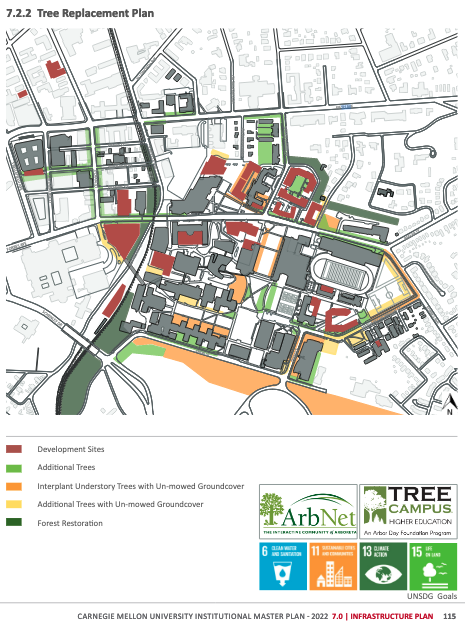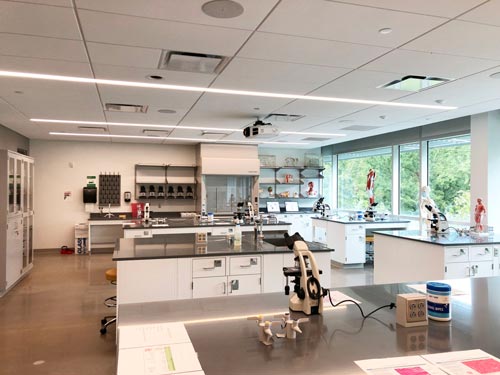Green Campus Futures
It’s Back to School season, and we are excited for our annual return to campus for members of our team who are teaching and/or studying, but also as design consultants and planners working with many institutions of higher learning in the US. Our internal tracking reveals a steady increase in university green building projects, which have always made up a chunk of our work but over the last two years increased to comprise nearly half of projects pursuing LEED certification. Furthermore, our involvement in campus-wide environmental planning efforts at schools like Carnegie Mellon has continued to branch into ongoing project work to improve the performance of landscapes and buildings while accommodating institutional growth. The higher education sector is deeply valuable to global climate efforts as a significant built environment portfolio that is usually expected to set an example for innovative ecological practices, where design and planning decisions have the potential to impact millions of square feet of built space and many opportunities to set new standards exist.

Carnegie Mellon’s 2022 Institutional Master Plan (IMP), developed by the university with assistance from evolveEA, Urban Design Associates, and GAI Consultants, illustrates an inclusive campus vision based on the university’s values as well as the UN Sustainable Development Goals. Our spatial and landscape analysis resulted in sustainability strategies, stormwater management integration, transportation and mobility strategies, and a comprehensive tree canopy analysis that led to development of a tracking tool to measure progress toward reforestation and tree replacement goals. (IMAGE: Tree replacement plan excerpted from 2022 IMP)
One of the consistent features of campus greening that we have helped drive over the past two decades is the deployment of sustainability frameworks as a tool for advancing project excellence. Primarily our clients have been guided by USGBC LEED rating systems for buildings, and many schools boast a minimum LEED certification level for all future projects as a matter of university policy. A trend gaining pace lately is the incorporation of additional campus-wide design and construction policies based on LEED standards, not only at the building scale but also pertaining to landscapes and the broader urban context in which most universities are situated. For many schools, this means analyzing the neighborhood around the campus as well as city-wide systems that the campus community relies upon, such as mass transit and mobility networks including pedestrian and bike facilities, the power grid, water and sanitation, and green space networks. This is where neighborhood and district scale frameworks like EcoDistricts and LEED ND are also influencing universities at high levels and informing key decisions about how campuses develop and evolve.
Strategies & Trends
While every institution has unique cultural and physical characteristics, we have found that a number of approaches to campus greening can be applied across them all.
- We start with the goals of the university, then create a customized approach for projects. Universities have goals related to USGBC LEED certification, EUI/WUI resource use, zero waste or AASHE Stars, or typically some combination. Universities have a longer term horizon to benefit from durable construction.
- The Integrated Design Process with stakeholder engagement is invaluable as a way to engage and educate, particularly at the start of projects. Students, faculty, staff and other stakeholders desire sustainable projects.
- Every university can benefit from one or two ambitious high-performing projects. These can help to teach students and inform the overall portfolio and be a selling point for the campus.
- The central steam and chilled water systems common to so many universities create a barrier to the net zero goals that many universities have. While these systems have benefits, they are typically powered by gas.
- The Inflation Reduction Act will be a game changer, offering financial incentives for sustainable design previously unavailable to universities.

Biology laboratory at LEED Gold PSU Ostermayer Hall. Photo courtesy of BCJ.
Densification is a key sustainability solution for efficient land use. Urban redevelopment has continued to increase in US cities, sometimes impacting communities in undesirable ways. In cities where real estate values have led to displacement and space has become more and more expensive, the respective goals of neighbors and nearby institutions have at times diverged or caused conflict. Many universities have responded by engaging more meaningfully with neighboring communities and seeking ways to foster integration between campuses and neighborhoods—both physically and socially. EcoDistricts could be considered influential in both areas due to its focus on social equity, especially related to planning processes, while frameworks like LEED and WELL promote facilities design that encourages an active lifestyle and healthier indoor spaces.


